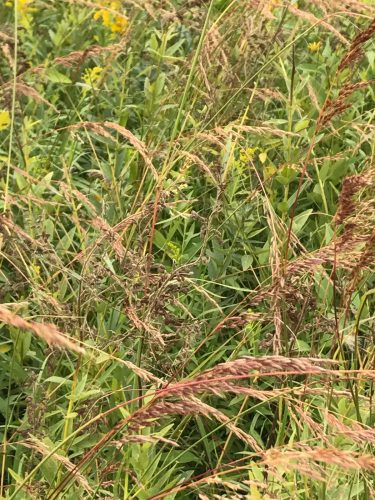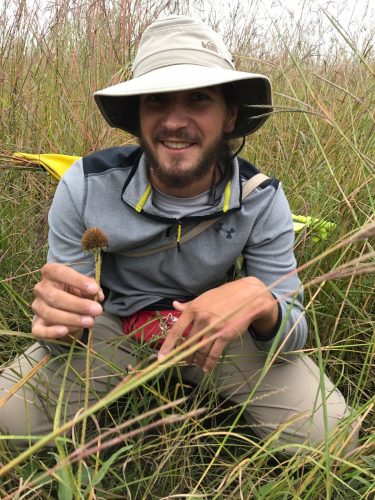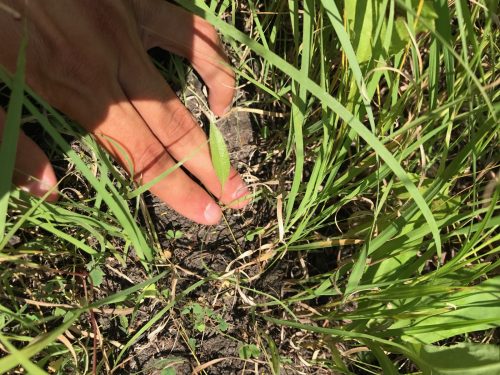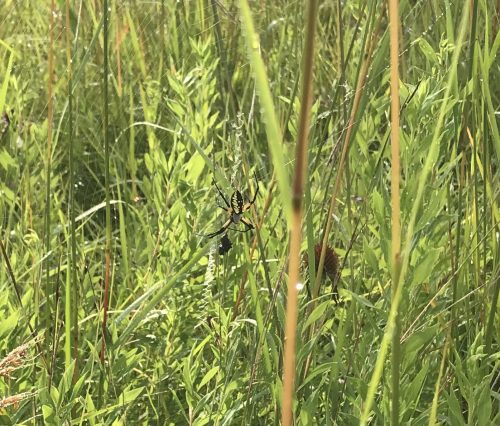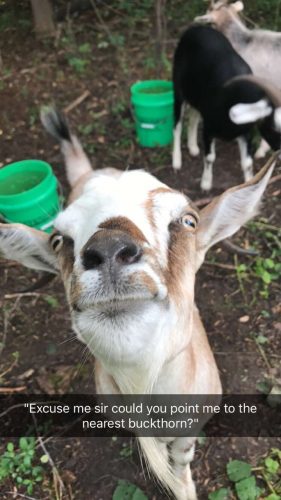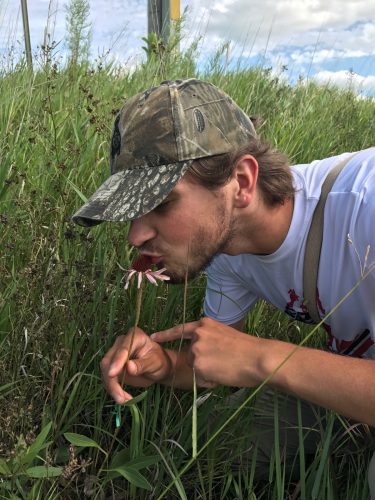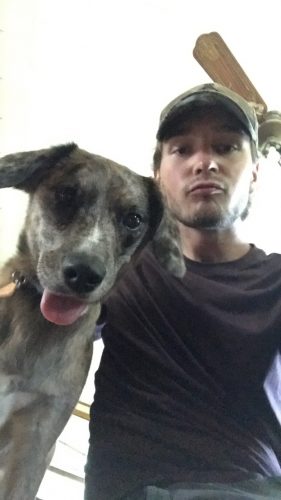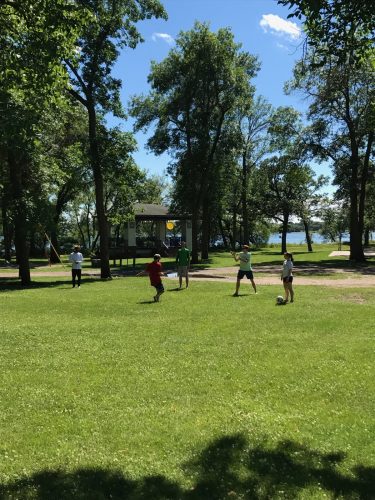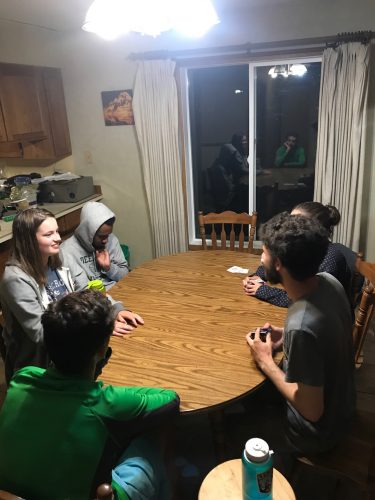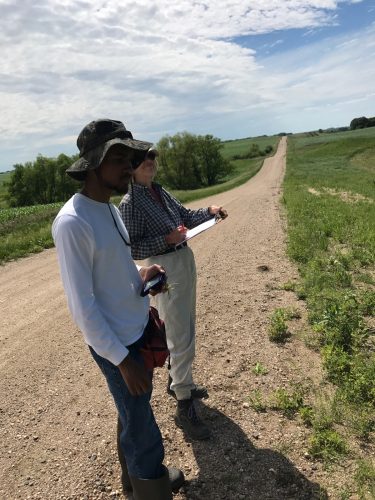|
|
Today was my last day in Solem Township with Team Echinacea. Three of us (Andy, Michael, and I) went out to Hegg Lake and did demography in the morning while the rest stayed back and worked around Hjelm. Demography at Hegg lake is a mess. The mini-sites are very far from one another and the walks to get to these sites is through swamp-like substrate and tall grass and reeds. There was also loads of showy tick trefoil (the stuff that sticks to clothes) and it got all over me, resulting in a half-hour of me picking those off.
 Showy tick trefoil is something to look out for when plodding through prairie! During lunch, I presented the preliminary results of my pt7 hybrids project and Stuart made some super yummy apple crisp! Michael and I went back out to do more demography at Hegg Lake (no stickies this time), and the rest of the team collected seed from pt1. We finished my last day with a discussion on the workings of aster analyses. This really got me excited to work on my project’s analysis!
 Me and the first flowering plant at experimental plot 7! I will miss this place! See you soon, Team Echinacea! Thanks for the glorious memories! I will never forget this experience and all of the great people I have met. It’s truly inspiring to be in the presence of such amazing scientists and people!
 You’ll be missed, Team Echinacea!
Hello Echinacea Project readers! My personal project is actively taking place in experimental plot 7, a hybrid plot planted in fall of 2013. The primary purpose of the plot is to assess relative survival and fitness in Echinacea angustifolia and pallida, as well as hybrids of the two species. Data on survival, number of leaves, and size of these plants has been collected over the years. I will be using this data in an aster analysis to determine which cross type is the most fit. Unfortunately, only one individual has flowered over the time this plot has been around, and it was a pure E. pallida. From preliminary looks at the data, conspecific angustifolia seem to have the lowest survivorship and have the smallest average leaf length!
The other part of my project is assessing the physiology of these plants. For this, I have been using a Licor Li-6400xt, which can assess rate of carbon assimilation as well as transpiration (loss of water) in leaves. Getting the machine to work properly on Echinacea leaves took a ton of stress and time from me, but luckily it is up and running now. Using these measures can hopefully give us insight into why pure angustifolia crosses have lower survival than others. As I post this, I have made many observations on what factors affect photosynthetic rate the most in the plants. More shaded, thinner, lighter leaves, and partially consumed leaves all seem to display lower efficiency! I am really excited to integrate all of this data and ultimately analyze it!
 Taking apart the Licor chamber to get it to work on Echinacea leaves… This was stressful.  A tiny basal Echinacea in pt7. The variation is incredible!
began the day with syncing visors in preparation for measuring plants at experimental plot 2. The majority of the team convened there at 8:30 and proceeded to measure, do phenology, and harvest heads at pt2. Some of us stayed back and finished measuring experimental plot 1 – specifically in the dreaded 99 South Garden. To add to the general dread, we saw a garden spider hanging out in the garden on some Indian grass!
 The big garden spider (Argiope aurantia) in 99 South was a bit scary at 9 in the morning! In the afternoon, I worked on measuring the functional traits (photosynthetic rate and transpiration) of hybrid Echinacea in experimental plot 7 with the Licor Li-6400XT named Helga. I’m very excited to finally have finished one row of measuring with Helga, as I have greatly struggled with equipping her to effectively measure Echinacea leaves.
 I take apart and make modifications to the measuring apparatus on Helga, the Licor (Truly one of the more stressful moments of my life). The rest of the team dispersed for the afternoon, and a lot was accomplished in a little time. Some people went to do demography in the remnants, while others did their independent projects in the various sites within Solem Township. The day ended with a number of us harvesting ripe side oat seed from experimental plot 1. The goal is to eventually spread the native seed in experimental plot 8. The night ended with me cooking a dinner for the roost and then the crew watching the season finale of the Bachelorette! Go Garrett!
P.S. The goats are great fun to have close to the Hjelm House and pt1!
 A rather self-explanatory picture of Style.
Today, we started out the day in task forces and disperse throughout the common gardens and remnants. A number of us worked on p1 phenology and got absolutely soaked from the wet big bluestem. After that, many of us went inside while drying our stuff outside to work on R coding for our projects (I made a map of angustifolia and pallida ranges in the United States). The CoWBee team spent their whole morning at p2 working on their projects as well, and we were all able to convene for lunch, where some individuals gave us updates on the status of their projects.
After lunch, Kristen brought a team to move emergence tents around the prairie. The rest of us went out and did demography at the Loeffler’s corner, railroad crossing, and northwest of landfill remnants! The day ended and we all were happy to be home! I worked on writing a proposal for my project at night (and finished the map), and the rest of the roost team, along with Kristen and legendary Team Echinacea member Laura Leventhal, cooked a fried rice and tofu dinner for us all! The night ended with more intense games of Werewolf!
 I kiss an Echinacea at the Northwest of Landfill remnant
Today was generally a lazy Sunday, as many members of the Roost were seen sitting around and reading or working on various project activities. Additionally, a few members of the team were out and about completing various tasks around the state of Minnesota. Notably, Zeke and Kristen went out early this morning and moved around emergence traps at West Hegg Lake with the help of the new GPS named Darwin. In mid-afternoon, Evan, Mia, and I went to Aldi and Elden’s to get groceries for our weekly meals. Mia made some awesome roasted veggies tonight, I am making tuna pasta pea salad for Tuesday, and Evan is going to make his family special sausage and noodle recipe.
Later in the day, Andy and I played tennis, and then Will and Kristen came over to play the new card game Werewolf. This game has been a staple of the Roost over the week and weekend, and it certainly can make us yell at one another, as we try to figure out who is the Werewolf in a village of good people; plenty of lying occurs. However, I think we can all agree that the end of the day that Werewolf brings us closer, and we wouldn’t give that time up for anything else. I will say that I am very happy with the weekend and I think we are all well and rested for an amazing week ahead!
P.S. I’m going to miss having Blue around the Hjelm house.
 Zeke drives his car.  A great selfie with Blue! She will be missed.
On this great Sunday to start off the month of July, the Roost woke up to rainy skies and an expectation of a rather laid-back day indoors. Fortunately, the weather cleared for sunlight and team CoW Bee was able to set up P2 for our Jennifer’s experiment by painting, bagging, and crowning flowering Echinacea heads. Thereafter, the Roost squad (and Kristen) reconvened at the Roost and decided it was time to turn away from the prairie ecosystem to relax at the limnetic Lake Agnes in Alexandria. At the lake, we engaged in common leisure activities some may call sport: kanjam, swimming, frisbee, and soccer. This small excursion was a morale boost for the team; we found that our fellow roostmates have skills other than searching for melted toothpicks.
 Evan, Zeke, Michael, Brigid, and Andy simultaneously pass the soccer ball and the frisbee. After sports ‘n stuff at the lake, the team decided to plant our taproots and relax for the afternoon before dinner. Mia cooked dinner tonight with the help of Kristen. It was a lovely combination of sautéed onions and peppers in a noodle matrix, with a fresh salad prepared from veggies we got from the house’s CSA. Once dinner ended, the squadron decided to disperse to get some work done or just relax. Into this wonderful time of relaxation, someone (this individual will remain unnamed) decided we should play a “super fun card game” called Mao (named after the late Chinese leader Mao Zedong). This game makes no logical sense, as it consists of an Uno-like base game in combination with rules generated by players, except nobody knows what the rules are… As one can imagine, this game is not fun, and I quickly left to engage in more productive activities – like writing this flog post and reading a paper for our journal club. As the Roost begins to settle down for the night, I ask myself, “what joy is found in playing an effectively rule-less card game in which people are actively raging?” I personally do not know the answer, but I will perform a thorough investigation at the Hjelm house during lunch tomorrow. Until then, remember to never listen when someone says, “hey let’s play this fun card game but I get to make up all the rules and not tell you.” Happy July!
 Evan, Mia, Zeke, Michael, and Brigid play the “game” Mao.
Evan-
The first thing that comes to me when I think about East Riley is definitely the poison ivy. The notorious three leafed plant made me hesitant to get any closer to investigate the site. Fortunately, there were a few Echinacea plants present closer to the side of the road. Both sides of the field were bordered by agricultural fields. The agricultural field facing north was growing soybean while the field facing south was growing corn. When out at the site I didn’t notice any solitary bees flying around, but next time I’m at East Riley I would want to observe how frequently they fly to this specific site even with the large amount of poison ivy present.
Riley-
Nothing is more exciting than arriving to a site that shares one’s name. That being said, I had high expectations for a locale sharing my alias; I anticipated a diverse array of species as well as a slew of budding Echinacea heads. Unfortunately, my wish for high species richness did not come true, but I was lucky enough to spot 8 Echinacea heads. Although the exact land use history of the site was unknown to myself, I could only speculate (with the help of Ruth) that the land was previously used for agriculture due to low plant diversity and a lack of remnant prairie indicator species. My experience at East Riley as one of my first impressions of a non-remnant prairie will leave a lasting impact on me because the difference in plant community composition between it and remnant prairie is so immense. It is amazing to me how years of land use can be summarized by a plant layer on topsoil and how much we can learn from this green blanket.
Ruth –
As the member of our team who had been to East Riley quite a few times, I noted its usual great extent of bare ground from which numerous Echinacea with nicely developing flowering stems were emerging. Here, there is a rather wide (over a meter, I’d say) road edge that is level with the road surface. This edge is frequently scraped by snow plows and other road maintenance equipment. The mature Echinacea, with their deep taproots, tolerate this remarkably well, resprouting over many years. Other species typical of unbroken prairie, like leadplant, are not abundant here and may be less tolerant of the scraping. At this site, we have found many seedlings of Echinacea each year for a decade and have relocated them in subsequent years to monitor their survival and (eventual) flowering. Amy Dykstra led this seedling project and has been working on this dataset this year. I don’t remember such vigorous poison ivy in the past. Important to beware of that patch!!
 Ruth draws a map of East Riley while Evan enters site data onto his Visor.
Biology, Gustavus Adolphus College 2019
Research Interests
I am interested in a wide variety of ecological disciplines, but I have found that population ecology and population genetics have come to the forefront of my interests. Additionally, I am interested in physiological adaptations and how these can vary within populations. I am excited to work with Team Echinacea because it will give me the chance to perform intensive field research with a group of individuals who have similar goals and interests as myself! More specifically, I hope to study within and between remnant mating of Echinacea and how this can affect fitness or physiology of individuals within the populations.
Statement
I grew up and lived my whole life in Bloomington, Minnesota, less than a mile from the Minnesota River. In my free time I enjoy hiking, outdoor leisure activities (softball, hammocking, etc…), and enjoying time with friends and family. I have a special spot in my heart for statistics and last summer applied my training to helping out with medical research at the University of Minnesota’s Schulze Diabetes Institute, where my father was previously cured of his Type I Diabetes.

|
|
